Many students and parents seem to really hate the Common Core. The new strategies can be confusing and unfamiliar, and what we see when parents come to us at BMT is often more struggle than learning. I dug a little deeper into the origins of the Common Core standards for grade 4 division, and found some useful information for easing the pain of the new material.
What’s the deal with Common Core Division?
The intended goal of the standards for 4th grade seems to be to expose students to multiple ways of solving division problems, and to allow them to solve more complicated problems than they otherwise would be able to without using the traditional Long Division method right away. The main strategies are:
- Modeling: Students draw pictures to represent the problem
- Skip Counting: Counting by 2s, 3s, 4s etc, and seeing how many times you need to skip-count in order to reach the desired number
- Partial Quotients (or the “Big Seven”): This is a strategy in which students break down a seemingly complicated division problem into friendlier, more digestible chunks. (This is the one that seems to give a lot of people the heeby-jeebies.)
- Area Modeling: A visual approach to dividing up a large rectangle into smaller pieces to visualize and complete the division problem.
What’s the Point of All This Nonsense?
From reading the common core standards themselves, and comparing their strategies with my own experience as a student, tutor, and teacher, I actually (bear with me here) LIKE the new division techniques for a few reasons:
- They emphasize having several ways to solve a problem, and picking the strategy that feels most comfortable for the particular situation at hand. Not only is this a useful skill in school, internalizing this idea can have many real-world benefits if students hold onto it through their lives.
- These methods in particular show that a seemingly scary problem like 136 / 8 can actually be broken down into smaller, easy problems, 80/8 and 56/8. Learning to break down problems like this is ESSENTIAL for students further success in math, science, and beyond.
- It gives students the sense that there’s some meaning to the mathematics. By learning how to visually split up a number into boxes, such as in the “modeling” method, students begin to get the sense that mathematics can have meaning beyond just numbers and symbols. It maps the act of working out division problem very clearly to the concept of splitting a large number into smaller equal parts. Very often the reason that students dislike math is that it seems like a meaningless string of rules to memorize. Reinforcing the connection to concepts helps prevent this.
An Example:
To understand why the common core techniques are actually kind of nice, (once we get past the initial headache) let’s take a look at solving a problem using traditional division methods and the Partial Quotients or “Big Seven” method. Here’s a pretty typical division word problem
Debbie wants to divide her collection of 136 coins into 8 boxes, with each box containing the same number of coins. How many coins go in each box?
Traditional Long Division:
| Mathematics | Explanation |
|---|---|
 | Setup of the problem |
 | Does 8 go into 1? No. |
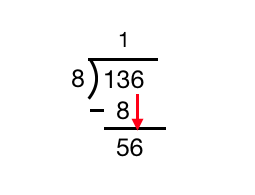 | Does 8 go into 13? Yes, once. So let's put the one on top, multiply, subtract, and bring down. (A good question to ask here is WHY? Why do we do this multiply, subtract, bring-down?) |
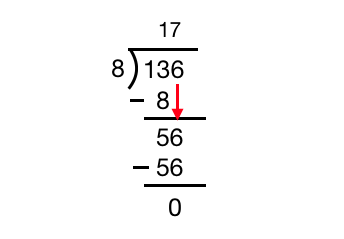 | Does 8 Go into 56? Yes. 7 Times. So we repeat the process of putting the result of the division on top, subtracting, and "bringing down." Since there's nothing to bring down, we're finished |
Common Core Partial Quotients:
The best thing about this method is we can explain WHY it works. We try to figure out the number of 8’s that go into 136 by picking a reasonable guess, and seeing what we have left over. Keep that in mind as you follow the example.
| Mathematics | Explanation |
|---|---|
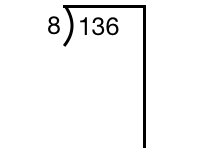 | Setup of the problem with the notorious "Big Seven" We're trying to solve "How many times does 8 go into 136?" or "What is 136 divided by 8?" |
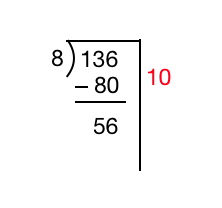 | The first step is to take a guess at the number of times that 8 goes into 136. Any guess will suffice, but lets try 10 times. 8 times 10 is 80, so that is a significant chunk of the 136 we're trying to divide. |
 | Now that we know that our original guess of 10 got us part of the way, we repeat the process for the remaining amount. How many times does 8 go into 56? Multiplication tables tell us 7 times. |
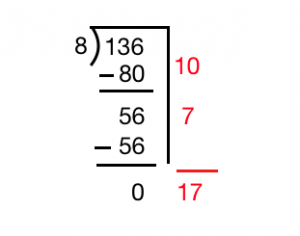 | At the end, we simply add or count up how many times we put 8 into 136, which answers our original question: "How many times does 8 go into 136?" |
The Big Downsides:
Unfortunately the good intentions of the Common Core creators have been difficult to apply in many classrooms. Teachers can end up presenting each of these methods as entirely separate procedures to memorize, and kids end up feeling more overwhelmed than empowered. And there’s always a danger that in an effort to give kids an early window into the deeply expressive power of mathematics, the Common Core takes things too far into the realm of abstraction. I think a well-implemented version of these standards could really open doors for students interested in a “mathy” way of thinking and increase the level of math literacy among the entire population, but it’s got to be done right.
What Can Parents Do?
Understandably, the new methods have come with some serious growing pains. It’s no wonder that parents end up feeling frustrated, helpless, and confused about how to help their children. Below I’ve listed a few ideas for how to take action:
Take some time to get comfortable with the new rules: We know the last thing that parents needs is more homework for themselves, but like it or hate it, it seems that the Common Core is here to stay. By getting comfortable with the new methods yourself, you can provide the support your child needs to master these topics.
Find online resources: This is especially important if the teacher seems to be ineffective. There are loads of online resources including texts, videos, sample problems, and more from great teachers who really know the common core math inside and out. See the “resources” section below.
Get outside help: Contacting tutors, other teachers, and other parents is a great way to pool knowledge and alleviate the frustration of not knowing how to help.
RESOURCES:


